An international summer school titled INTIMACY IN WOMEN'S WRITING AND READING took place in Ljubljana, from 22nd to 27th August 2022. It was organized within the CEEPUS Network Women Writers in History, by the University of Nova Gorica, and supported by the organization Women Writers Route and others.
Twenty-two students, from seven different countries (Bulgaria, Poland, Romania, Slovenia, Serbia, Croatia and the Czech Republic) participated. Lecturers came not only from the aforementioned countries, but also from Great Britain, Latvia, Finland and Sweden.
A two-day conference – Censoring intimacy in women's writing and reading in the long nineteenth century: 3rd international exploratory workshop – was organized as a part of the summer school. The collection of abstracts titled Censoring intimacy in women's writing and reading in the long nineteenth century: 3rd international exploratory workshop : 23-24 August 2022 Ljubljana, Oton Župančič Library / [editor Ivana Zajc]. - Nova Gorica: University of Nova Gorica, 2022 ISBN 978-961-7025-23-1 COBISS.SI-ID 115581699) is available at: https://www.ung.si/documents/1260/Booklet11_8_V8UoDBm.pdf.
We are sharing, herein, a detailed report on the lectures, events and impressions from one of our participants from Serbia, Marija Bosančić, a PhD student at the Faculty of Philology, University of Belgrade.
Impressions from Ljubljana
During the last week of August 2022, we were a part of a creative summer school in Ljubljana, organized by the University of Nova Gorica. We discussed intimacy in women’s writing and reading ( Intimacy in Women’s Writing and Reading, CEEPUS Network Women Writers in History ), where the main question we faced the very first day was: What is intimacy/intimate for us? During those six days, we considered this question in various types of contexts, not only formally, but also informally – we listened to each other, had in-depth discussions, and shared our understandings and ideas which could possibly be of importance for any future analyses of intimacy and censorship in literature.
From the very beginning of the summer school, we felt the heart-warming welcome of our hosts, in Villa Zlatica,[1] where we participated in the first workshops held by Prof. Maša Grdešić and Prof. Carmen Duțu.
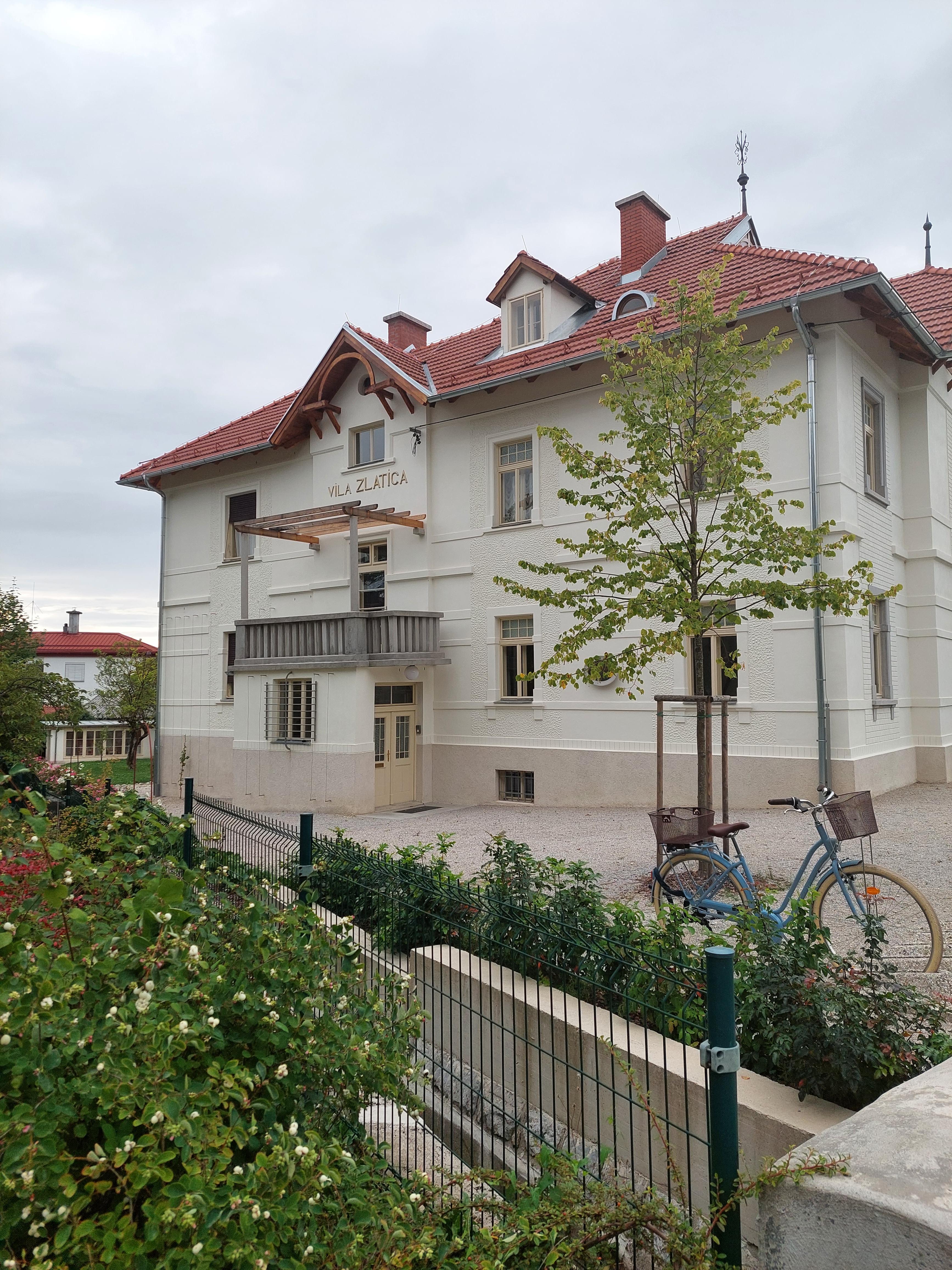
Villa Zlatica
It was there that we embarked on our journey of various discussions about intimacy in literature and what it encompasses; we touched upon questions such as why literature abundant with emotions is labelled as feminine or frivolous; why less significance is given to it when compared to that belonging to the literary canon; why the canon is still rejecting it; in what ways the women authors had to be inventive in order to pave their way towards freedom of expression, and thus, a free space. The lecture of Prof. Grdešić included, as well, an on-the spot analysis of concrete examples – sampled texts of four contemporary Croatian women authors: Jasna Jasna Žmak, Nora Verde, Lucija Tunković and Lana Pukanić. We were then introduced, through an experimental exercise and a theoretical lecture held by Prof. Duțu, to the idea that a universal definition of intimacy does not exist per se, but that there are different intimacies which are, so to speak, individual, although they do not exclude or threaten each other. Instead, the boundaries between them are rather blurred and intertwined, thus opening a new fluid space, in contrast to a static and clearly divided one.
We had somewhat of a short break from the workshops during the second and third day, when we attended the conference Censoring Intimacy in Women’s Writing and Reading in the Long Nineteenth Century, Exploratory Workshop, which was organized within this project. By giving us the opportunity to hear these lecturers, the organizers made sure we were given a chance to broaden our horizons and knowledge on this particular subject matter. The conference was opened with an introductory speech given by Prof. Katja Mihurko Poniž, the main coordinator of this project, and Dr Alen Širca, chair of the Slovene Comparative Literature Association.
With a concise and coherent introductory lecture Introducing Intimacy and Censorship, Prof. Mihurko Poniž presented to us the main concepts and issues which go hand in hand with the analysis of intimacy in literature, i.e. feminine literature – starting with the existence of a plethora of women authors who hid under pseudonyms, all the way through to an abundance of examples of self-censorship, gender censorship and censorship of ego-documents.
The following lecture we listened to was Reader and Author as Censorious and Exposing Agents: Experiential Readings of Responses to Censored Intimacy in Swedish Alfhild Agrell’s Räddad , delivered by Prof. Birgitta Lindh Estelle. She indicated that censorship has always been present, but hidden behind various masks, re-shaped in different forms, never of the same intensity, while she also underlined that readers understand the text through their own experience and, therefore, respond to it differently, depending on their social status (more or less accepting certain ideas at the given moment). By building on Helen Freshwater’s definition of censorship and by accepting Toril Moi’s idea of the act of reading as a mood rather than a method, Prof. Lindh Estelle aims to focus her attention towards the transnational strategy of mapping women’s creativity which suppressed or, rather, uncovered something intimate.
After, Prof. Duțu presented her lecture Censoring the Nation: Martha Bibesco’s Exile of Intimacy, which gave us a detailed insight into the theoretical framework Prof. Duțu has been working on, supported by the example of Martha Bibesco, an author who found herself on the border: a Romanian woman writing exclusively in French. This, actually, brought up the question of marginalized writers who aspired to deconstruct the ever-lasting narrative of exile through their transnational perspective.
The lecture of Prof. Alenka Jensterle Doležalová, How to Become a Poet at the Turn of the Century: Male Censorship and the Female Poet , gave us a chance to hear a bit more about Vida Jeraj, a Slovene author, and her creative process, but also the influence, and in that respect, pressure she endured by her male “colleagues”, literary critics – Josip Murn-Aleksandrov and Anton Aškerc. This lecture (possibly) led us to further consider how much women authors, and in general women artists, were limited and restrained in their creativity, how much the male opinion shaped and identified them – and most importantly, how much the same most likely occurs to this day.
The following lecture, energetic and inspirational, was delivered by Dr Henriette Partzsch on the topic of Correcting Unfeminine Emotions: Translator Interventions in French and Spanish Versions of E. Marlitt’s ‘‘Das Geheimnis der alten Mamsell” [The Old Mamsell’s Secret, 1867]. Dr Partzsch drew our attention not only towards the fact that much can be lost in translation, but also that a lot can be deliberately omitted in order to win and/or educate the audience. What was considered inappropriate (emotions) or offensive (from the religious point of view), was limited or adapted so as to correspond to the “universally acceptable” (male) rules and/or values. However, having in mind that these novels Dr Partzsch talked about follow the development of the main female protagonist and that they were mostly aimed at and written for women and children, the translators’ direct interventions on the text point towards a wish and a plan to “easily” influence the reading audience, in order to gain tight control over it or “preserve” it from unwanted emotions (most likely anger) and ideas (most likely rebellion).
The last lecture of the first day of this conference was dedicated to the promotion of the following book: Women Writing Intimate Spaces: The Long Nineteenth Century at the Fringes of Europe, led online by Prof. Viola Parente-Čapkova, presented through a discussion with a special guest from the publishing house Brill, Christa Stevens, who provided more information about the publishing process itself.
However, the end of the lectures did not signify the end of our day. We went on an organized tour of Ljubljana. The starting point was the Oton Župančič library from where we headed towards Miklošičev Park, where we saw his bust. We continued along Miklošičeva cesta where, as our tour guide explained, the most beautiful, colourful, and carefully preserved buildings of national significance are located. Then we arrived to Prešeren Square, where our guide shared a touching story of France Prešeren’s unrequited love for young Julija Primic, the daughter of a wealthy merchant.

Prešeren Square, Ljubljana
Then we took Wolf’s street all the way to Park Zvezda through which we could glimpse at the Congress Square and the University of Ljubljana on one side, and the Ursuline Church of the Holy Trinity, the Slovenian School Museum and Jože Plečnik High School on the other. We went down to the river, crossed the Ljubljanica over the Fishmarket Footbridge and headed towards the town square and the municipal office through the Ključavničarska Street. All along this tiny street, we were walking next to a sculpture made by Jakov Brdar, with the aim to show that everyone goes through life while changing an infinite number of masks. Arriving at the square by the municipal office, we saw a lovely fountain inspired by Bernini’s Fountain of the Four Rivers in Rome, i.e. the Robba Fountain or Fountain of the Three Carniolan Rivers, a personification of the Sava, the Krka and the Ljubljanica. Our next stop was the Ljubljana Cathedral (officially named Saint Nicholas’ Church), dedicated to Saint Nicholas, the protector of fishermen and sailors. From that point we moved on to the market, observing the (at that moment) empty space which we could, thanks to the image our guide painted with her words, imagine to be quite lively in the working hours. By passing the whole market space, we reached the Dragon Bridge, Ljubljana’s first reinforced concrete bridge. Then we came to the Vodnik Monument, dedicated to the poet Valentin Vodnik, placed in 1889 in front of the Ljubljana Lyceum with the idea that he would greet the students who come into the school, once located on the square just behind the monument.
We ended our tour at the Ljubljana Castle, on top of a hill just above the city centre, with one of the most breath-taking sunsets above the Tivoli Park and Ljubljana as a whole.
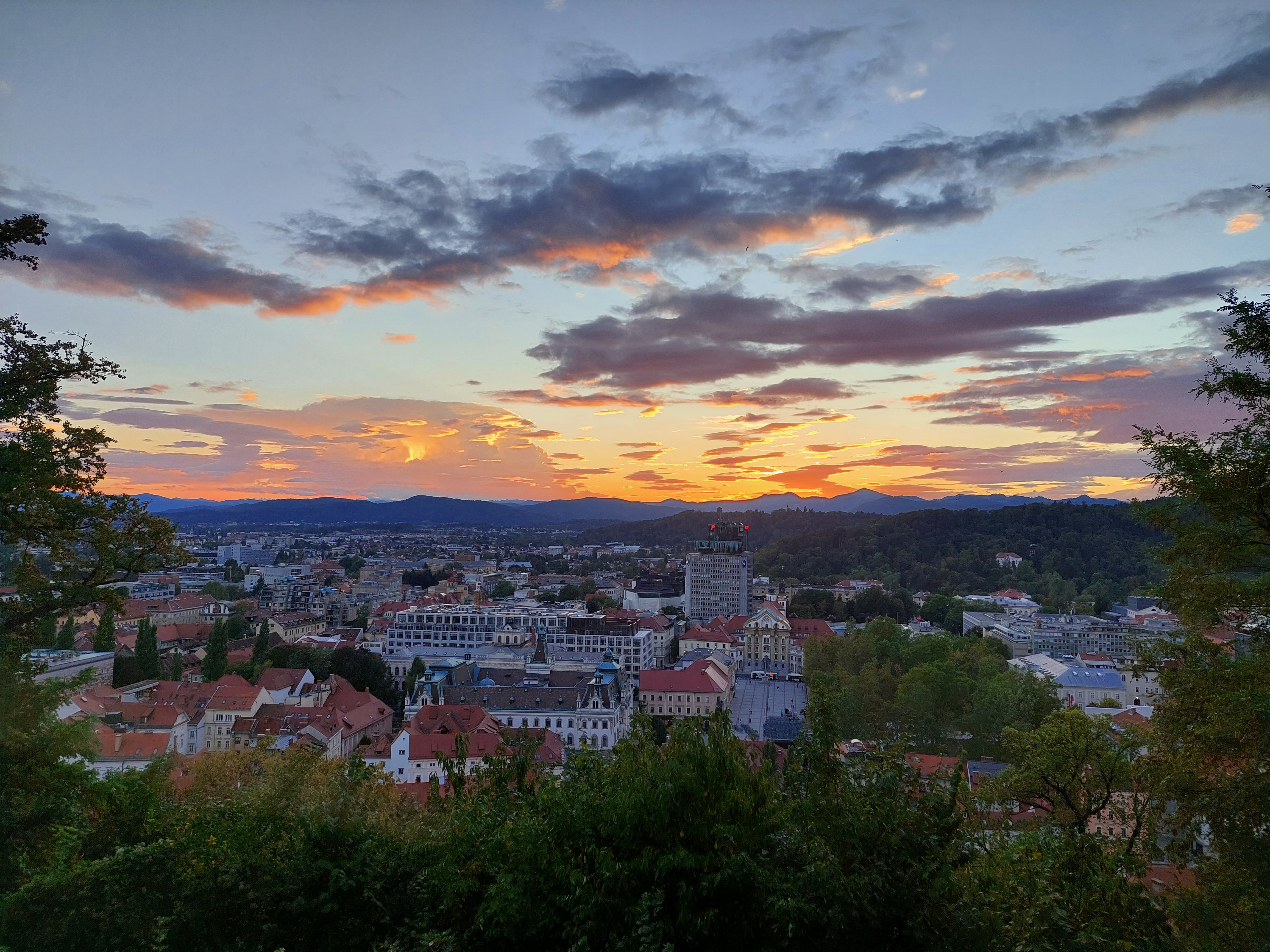
View of Ljubljana from the Castle
The second day of the conference began a bit earlier with the first lecture titled Censorship and Self-Censorship in Latvian Women’s Writing: Reading Intimate in Anna Rumane-Kenina’s Stories and Marija Eglite’s Diaries, delivered by Dr Eva Eglaja-Kristosne and Dr Zita Karkla together. Thanks to their lecture, we got a chance to learn a bit about Latvian literature and learnt that censorship did not include only ignoring women authors, but also being subjected to public and private ridicule, along with harsh and biased critique which influenced women’s creativity to a large extent. As only two women authors were visible in the Latvian literary canon up to the 1920s (Aspazija and Anna Brigadere), these two lectures focused on examining the relationship between censorship, intimacy and the female creative process by expanding the concept of female literature so as to include autobiographies as well. Both studies have shown that critique as a tool of censorship has highly influenced women’s writing, by silencing and suffocating its voice.
The following lecture was given by Prof. Elena Lindholm on the topic Sapphic Love between State Censorship and Self-Censorship: the Case of Elena Fortun (1886-1952) . It introduced us to the work of Elena Fortun and aimed to convey how much it was dictated by the regime in which she created. She was remarkably successful before Franco’s dictatorship, writing books for children about a rebellious girl Celia. However, as soon as Franco came into power, Fortun fled the country. Although she continued writing about the same female protagonist, a significant difference can be discerned in how she was written before and after that point in time. She blends in with the “female” mould and norms of what a girl/woman should be in Franco’s regime, which brings us to three key levels of censorship which were analysed in this presentation: 1. Direct state censorship which affected the publishing process in the Spanish market during the Franco regime; 2. Indirect influence of the Spanish state censorship on the exiled author; 3. Self-censorship of a homosexual woman author in the 20th century.
Afterwards, Prof. Viola Parente-Čapkova gave a lecture on Sexual Dissidence, Intimacy and (Self-)Censorship in Manuscript and Published Work. Here we were introduced to a study dealing with the problem of censorship in published works and unpublished manuscripts of women authors who wrote in the Finnish language at the turn of the century. Comparing the published works with the unpublished manuscripts clearly shows the problem of self-censorship, since it unearthed daring passages that reveal the female protagonist’s hidden fantasies, which ranged from identifying with prostitutes to lesbian tendencies.
From Prof. Irena Selišnik we heard a lecture titled Self-Censorship, Family Interpretations of Women Lives and the Influence of Official Narrative, thanks to which we learned about three studies which had non-fiction autobiographies of three women who lived at the same time, were of the same profession (all were teachers) and were all married. What interested Prof. Selišnik the most, as she put it, was to find out how women spoke of and wrote about their lives and how they chose to show their most intimate details (from pregnancy to nationality). Then, how they weaved their story, which arguments and narrative styles were used when expressing the most important life decisions, all within a wider historical context.
MA Natalia Panas gave a lecture titled Double Censored Freedom? Moj život [My life] by Maga Magazinović. By using the category of cultural memory as the research method of what actually functioned in culture, Panas focuses on what was transferred to the memory medium, and what was purposefully left out of the collective memory as inconsistent with the canon. She pointed out that the intimacy which Maga Magazinović wrote about shattered all of the cultural taboos by describing intimate relationships, by putting special emphasis to the romantic ones, by giving herself freedom of thought and by openly supporting feminism, and all that within the two opposing understandings of censorship: 1. moral/erotic (stemming from the Kingdom of Yugoslavia) and 2. ideological/political (from the socialist Yugoslavia).
In her lecture titled A Censorship of One’s Own, Prof. Biljana Dojčinović presented a concise analysis of Virginia Woolf’s essay, Professions for Women, which opened the questions of self-censorship and self-imposed limitations. Prof. Dojčinović raised the following question: Why might Virginia Woolf have said she avoids writing about intimacy in any context? This might be understood as a consequence of sexual abuse she suffered in her childhood, which she does not mention until her autobiographical essay from 1939. Prof. Dojčinović pointed out that the goal of this study is to look into the effects this trauma had on Virginia Woolf’s works altogether and to see whether lack of intimacy was a disadvantage or an advantage to her opus.
Then, we had the chance to hear Dr Cecelia Annell’s lecture titled Intimacy, Desire, Sexuality: Strategies to Handle Censorship by Swedish 19th Century Women Authors. Dr Annell pointed out the dichotomy of a “pure” and a “sexual” woman and how it functioned as a strong tool for censorship of women authors when it came to writing about their intimacy, desire and sexuality. Dr Annell further explained that her main goal was to uncover strategies which Swedish women authors used to deal with censorship, in order to be able to write about intimacy and sexuality, while also making sure that said process could be interpreted as productive, not only repressive. Some examples of those strategies are: transfer of desire to another “sexual” woman; describing desire in a “pure” woman who does not give in to it; describing sexuality among women; describing religious longing towards Jesus Christ; describing a “pure” woman with sexual desires.
МA Dajana Vasiljevićova presented her paper with the title Reworking the Framework from the Literary Margin: The Croatian Female Writers and their Quest for Recognition from Late 19th Century to Early 20th Century, where she highlighted that her main focus of research is the analysis of different levels of censorship and self-censorship in outlining the female experience in contrast to the dominant discourse. Mechanisms of censorship cannot only be seen in private correspondence and autobiographical texts, but also in the ideological oppression and patriarchal pressures present in the narratives left behind by Dragojla Jarnević, Jagoda Truhelka, Maria Jurić Zagorka and Ivana Brlić Mažuranić.
The presentation with which the conference ended was given by Dr Primož Mlačnik and Dr Ivana Zajc, under the title: The Forbidden Speech: (Self)censorship in the Personal Correspondence of Women Writers of the Slovenian Modernism. They highlighted that the main focus of their study was the analysis of manuscripts written by Slovenian women authors such as Marica Nadlišek Bartol, Zofka Kveder, Marica Strnad and Vida Jeraj. Having in mind that the main channel of communication among them was mostly of epistolary nature, the main type of self-censorship was linguistic – the insertion of Cyrillic letters as a unique way of encoding and “hiding” a message when it came to intimate topics. Apart from this, we had a chance to hear about a few cases where women authors were censored by literary magazines, which were described in their correspondence.
Our day ended a little bit later though – after a literary night in Tivoli Park, organized as a part of the Days of Poetry and Wine Festival. The main poet and guest of honour was Carolyn Forché, an American poet and activist, who shared with us, in a rather charismatic way, her road to creativity and poetic expression. Moreover, we had a chance to hear a number of poems from her newest collection, both in English and Slovenian.
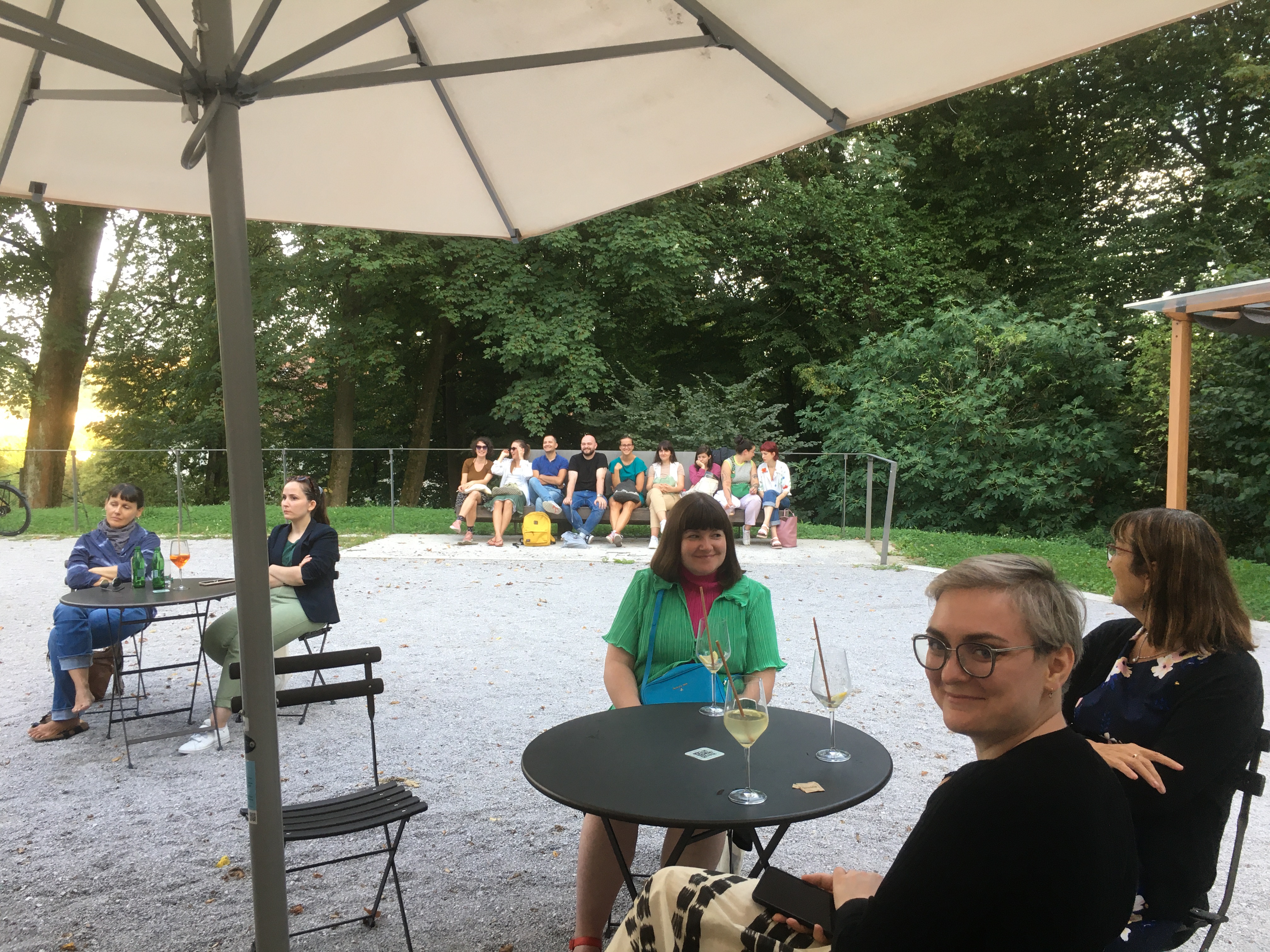
Relaxing at Tivoli Park
We spent our fourth day of the summer school on a wonderful excursion to Nova Gorica, Gorizia, Prvačina, Vipavski Križ and Vipava. Prof. Mihurko Poniž energetically led us through Nova Gorica and Gorizia, all the while sharing interesting stories about some relevant persons for those places. Afterwards, we visited the University of Nova Gorica, where we exchanged ideas on Intimacy. Women Writers and Digital Humanities in an informal lecture led by Dr Zajc. Dr Zajc talked about the role of digital humanities in literary analysis, its advantages and possible setbacks.
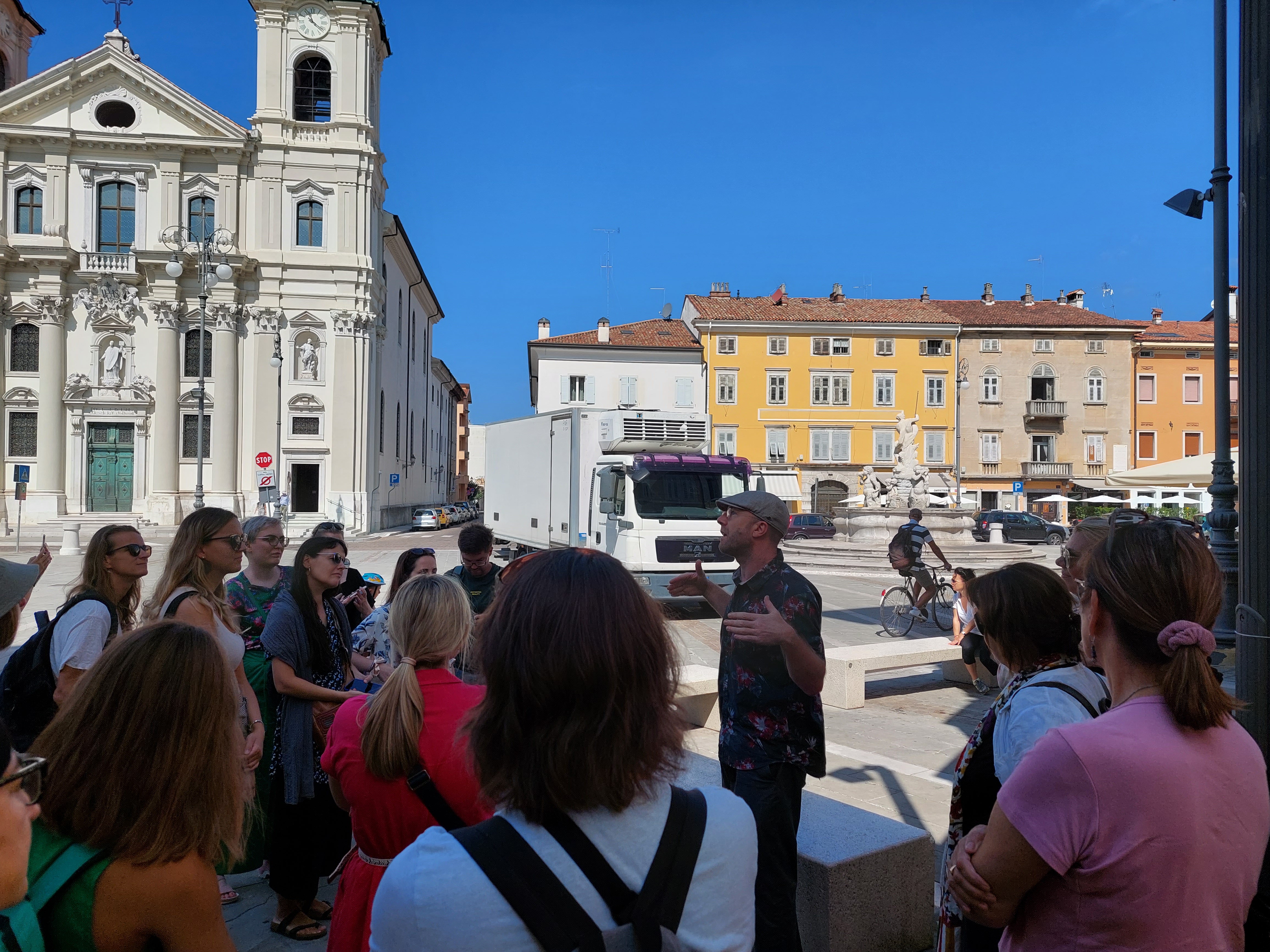
At the Square in Gorizia
All that had ostensibly been forgotten for a few moments when we arrived first at the Prvačina cemetery, and then to the Museum (Društvo za ohranjanje kulturne dediščine aleksandrink) dedicated to the Alexandrian women (Aleksandrinke), where we heard a rather emotional story about them. The sacrifice and resourcefulness these women displayed in order to step up when their families needed them the most, at a time when they had no other options, truly gave us food for thought. In the story we heard, it was pointed out that there were and are numerous (sometimes even) conflicted opinions on them, since not everyone thought about their sacrifices benevolently. Some deemed their departure to Alexandria in order to take care of other people’s children, at the expense of their own, to be some sort of a caprice, as if they were “chasing” after money, “freedom” from their husbands and/or children, as if they wanted to give in to promiscuity and infidelity. Some were lost, some kidnapped and taken into sexual slavery, some might have actually used the situation to their own advantage; however, most of them still tried helping their families, by (ironically) being a part of another one. The Museum perseveres and guards, as a sort of a time capsule, not only information about them, but also some items they brought back – clothes, trinkets, photographs, anything their families were willing to share with the rest of the world.

By the Museum of Alexandrian Women
From there, we went to see a rather charming place – Vipavski Križ, where we enjoyed a few moments of pure peace and quiet, gazing upon Slovenia and its greenery. In Vipava we had a chance not only to walk around, but also to try some local ice-cream. Looking back at it, I see how this entirely informal, yet highly informative day made it possible for us to get better acquainted.
The penultimate day was without a doubt marked by Prof. Svetlana Slapšak’s appearance. Before the talk with Prof. Slapšak, Prof. Dojčinović spoke about Jelena J. Dimitrijević, while Prof. Magdalena Koch presented the opus of Prof. Slapšak. This was a splendid introduction for our talk with Prof. Slapšak, who openly shared her experience with (state) censorship, all the while giving us an insight into a bygone era (Belgrade in the 1980s), an era that will most likely not happen again anytime soon.
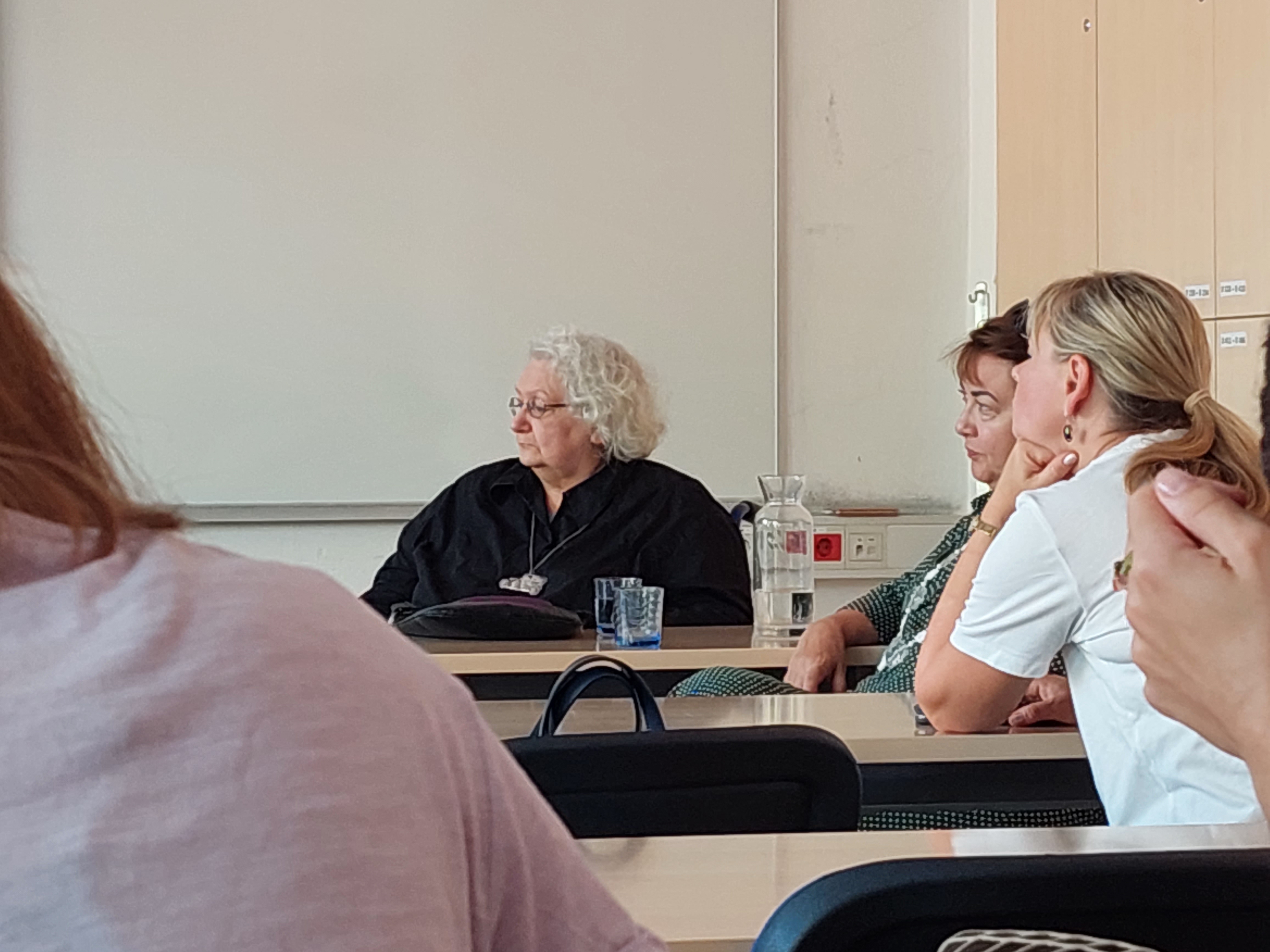
Svetlana Slapšak

During Prof. Slapšak’s Lecture
She also gave us homework of some sort – to destroy capitalism, because it is at the core of all current issues, starting with ecological ones. She shared with us, candidly, the “secret” to her creative process and told us which factors are necessary for being successful in writing – 1. An unconditionally supportive husband/partner, 2. Cats – as a form of therapy during the writing process, 3. Time. Time as the key ingredient, consumed by the current capitalist system – in all aspects. Prof. Slapšak’s words will remain in our memory, along with her cordiality, humour and ideas – she truly proved to be the missing piece of the puzzle both in our stay and the workshops, and for that we are immensely grateful to her.

Relaxed Conversations after the Lecture
The next workshop, Modernism and Intimacy vs. Patriarchy: Isidora Sekulić Enters Serbian Literary Scene, was held by both Prof. Dojčinović and Prof. Koch. We got the opportunity to hear a bit more about the opus of Isidora Sekulić and how progressive she and her works were for the time and society in which she created, and how it was neither recognized, accepted, nor commended back then.
On the final day we attended two lectures: the first one was held by Prof. Doležal, titled Intimacy in Prose and Novels of South Slavic Women Writers (Zofka Kveder and Julka Chlapec Đorđević), during which we saw a plethora of examples (i.e. copies) of their letters and texts and realized the importance of their work which resisted strict rules of how intimacy was to be presented in literature.
The other lecture was delivered by Prof. Nadezhda Alexandrova – Women as Protagonists in Popular Fiction in the Ottoman Empire: Four Bulgarian Case Studies from the 19th Century. Prof. Alexandrova systematically and energetically introduced us to four studies which showed that some problems are universal and independent of where certain literature comes from.
All these lectures and workshops opened many questions within the domain of literature and culture, which could be a great stepping point for further research. The hospitality with which we were welcomed and which was not lacking throughout our stay, the open-mindedness of all lecturers and their willingness to share ideas and listen to us, the wide array of academic experience of the lecturers and (us) the attendees – all of this was invaluable and made this summer school one of the most cherished academic experiences I have had (so far).
